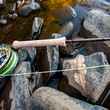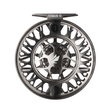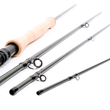Through a series of events as unlikely as finding a pearl in a brook trout’s mouth, I spent thirteen years in university administration—eight as a department chair and five as a dean.
“We have too many damn administrators,” one of my colleagues told me back then, seemingly oblivious to the title “Dean of Engineering” next to my name on the door he’d just walked through.
“How many should we have?” I asked.
“I don’t know, but I can tell you how to find out.”
“How’s that?”
“Start firing them one at a time and see how many it takes until someone notices they are gone.”
Like Aristotle, Ptolemy, and William of Ockham before him, the good professor was simply restating—in albeit draconian terms—a modern version of the dogmatic belief: It is vain to do with more what can be done with fewer.
On the other hand, the late Neil Peart of Rush fame pounded on a drum kit with more than thirty pieces, and I’ve never heard anyone say he could have done more with less. But for every Neil Peart, there are a dozen shitty photographers with backpacks full of thousand-dollar lenses and countless conference rooms stuffed with twenty-person committees vividly demonstrating that “No one of us is as dumb as all of us.”
Disposophobia—also known as hoarding disorder or Collyer brothers syndrome—is, simply put, the fear of getting rid of stuff. Benign examples include George Costanza and his leather bifold wallet overstuffed with assorted hard candies, emergency condoms, free guitar lesson tabs, and ten years of receipts from Monk’s Café. But the sickness can be severe, too. Here in the Upper Peninsula, a sixty-seven-year-old woman from Manistique recently spent sixty-two days in jail after authorities found approximately sixty-five cats and kittens in her home. Approximately? And the Collyer brothers themselves were found dead in their Harlem brownstone surrounded by mountainous stacks of old newspapers, sewing machines, umbrellas, rakes, phone books, horse bones, baby carriages, an X-ray machine, Steinway piano, dilapidated wine press, and well, you get the idea. Homer died from starvation and heart disease, while Langley stopped breathing after being crushed under a collapsed pile of suitcases, newspaper bundles, and metal bread boxes. With these backstories in mind, I recently held an intervention with myself to confront what I fear has become an out-of-control accumulation of fly-fishing accoutrements.
For the most part, I haven’t completely lost my mind. I don’t yet own a combination wading staff/fish finder, nor do I wear a pair of waders with built-in temperature control, GPS, a hundred-megabit wifi hotspot, and Bluetooth connectivity. I did have a pair of sunglasses with a built-in sonar bug finder on my Christmas wish list, but my wife said I should wait until they incorporate array-based Doppler processing with CDMA pulse compression. First-generation adopters are rubes, she says.
Because I’m the type of guy who likes to wear both a belt and suspenders, I attach nearly every gadget and gizmo I carry on the river with a primary and secondary tether. However, I did once lose my anchor on the Missouri River by thinking one of those carabiners with the spring-loaded release made attaching and detaching the twenty-five-pound pyramid easier than using one with a screw lock. As a smarter oarsman would have known, the rocks on the bottom of the Mighty Mo also find it easy to detach your anchor when it’s attached in such a careless way, so now I use two side-by-side carabiners with the openings facing in opposite directions, both with screw locks, of course, secured in place by two wraps of duct tape, just to be safe. Experience, they say, is that thing you get just after you need it.
I have a box in the basement that serves as a sort of accessory limbo. I’ve filled it with dull nippers, scratched reading glasses, tippet spools, tippet holders, old fly lines, hemostats, half-empty bottles of liquid and powder floatants, zingers, leader straighteners, amadou patches, Gink caddies, leader wallets, nail-knot tools, Thingamabobbers, stick-on indicators, clip-on flashlights, hook sharpeners, plastic pucks filled with retired flies, retractable tape measures, bug sprays, sunscreens, and an assortment of pastes and glues that could keep a kindergarten class busy for a week. Mixed among the relics are some dead houseflies, ladybugs, and several specks of rodent excrement resembling chia seeds. Everything in the box deserves a proper burial, but disposophobia draws its power from the seductive question, “What if?”
And taking that box to the transfer station won’t address the point of my self-to-self intervention. I’m more concerned with the boxes and packs I haul around in my truck and the gear and accessories I schlep to the river. If I’m carrying enough gear to make a combat marine say, “Damn it, man, that’s a lot of crap,” it’s probably time to cut back. But where do I start?
I once worked with a guy who had ten children. He told me people sometimes asked why he had so many kids, and when they did, he always responded with a question: Can you tell me which one we shouldn’t have had? He said he’d respond the same if he had nine kids or eleven. “No matter how many you have,” he told me, “they’re all special, and you can’t imagine life without any of them.” That’s how I feel about my fly rods, so I’m not cutting back there. Every rod needs a reel; every reel needs a line, so those aren’t on the chopping block either. Again, I ask, where do I start?
From somewhere around mid-April until December, the back of my Suburban looks like good old Homer and Langley Collyer stocked it themselves. I have two high-tech coolers—one hard-bodied and one soft—a hard-shelled storage box, two soft-shelled ones, a single-burner stove, two pairs of wading boots, two pairs of waders, two waxed-canvas packer hats, two rain jackets, a reel case filled with reels, three landing nets, and two gear packs—one for cricks and one for rivers. The number of rods changes like the weather, but there are always at least three back there.
On the river, my tippet system is spartan—a metal contraption holding spools of 3X, 4X, 5X, and 6X attached to my submersible lumbar pack by the plastic clip that comes with it, plus a backup locking carabiner, just in case. Because tippet is essential for fly fishing, I can’t cut back there, and because the tippet caddy is connected to the lumbar pack, I can’t cut the pack from my gear either. And since I will continue hauling the pack, I might as well keep the backup tippet spools that are already in it. Can you imagine what it would be like to face down an empty tippet spool without a backup in the middle of a brown drake hatch? I can’t either, and I don’t intend to find out.
By now, you can probably guess where this is going. I’m not cutting the amadou patch or its backup. The Dry-Shake and Gink aren’t going anywhere, nor are their reserves in the pack. Who goes out on the river without nippers, forceps, extra leaders, sunscreen, bug dope, and a line-cleaning system? But the truth is, none of these things are my problem. My problem begins and ends with the legions of flies crammed into the raft of plastic boxes that fill my storage crates and gear packs. In high school, I made a display with dead moths, beetles, walking sticks, cicadas, butterflies, grasshoppers, crickets, bees, and other insects I can’t recall. But I can recall swearing on a stack of the school library’s editions of the Life Nature Library: The Insects that I would never carry around that many bugs—dead, alive, or even manikins—in a box again. I also thought I’d drink nothing but Cherry Coke for breakfast, lunch, and dinner once I could make important decisions like that for myself. With age, though, we change in ways our adolescent minds can’t fathom.
So, here’s where I’ll start. I’ll pick one fly box, move its most reliable inhabitants to the others, and then throw what’s left of the box and its flies into the container in the basement. If I don’t notice it’s gone by the second week in June, I’ll pick another and do the same. I’ll do my best, but I know where this will likely end. For me, cutting back on fly fishing impedimenta is like cutting back on cigars was for Mark Twain: It’s the easiest thing to do, and I ought to know. I’ve done it a thousand times.
































Comments
Mike Garrison replied on Permalink
What a great article in every single way. The humor and the empathy for those of us that share the same predicament. I have had to stop carrying a backpack type fishing vest because if there is space...I will fill it. At 55+ carrying too much weight is a bad idea.
Tim Schulz replied on Permalink
Thanks, Mike! I'm glad you liked the story.
Bob DeMott replied on Permalink
Tim:
Having witnessed first hand the mountain of gear in back of your Suburban , you have your work cut out for you! Good luck with that!
Tim Schulz replied on Permalink
Hey, Bob, it is pretty bad, isn't it? ;-)
Winston replied on Permalink
Good article, Tim. Nearly every angler I know is so afflicted. I sure am. Every year I decide to go light and get rid of my old vests, etc. Sometimes I manage to give something away. Not often. Ninety percent of my fishing is less than 20 minutes from home (I’m lucky that way) and hatches are reasonably predictable, so I should be able to get by with a tiny box refreshed daily or weekly. Often I start the season like that. Then the extra fly boxes start to pile up in my vest, or back pack, or chest pack, whatever device I’m currently convinced is most convenient and comfortable. I might need that hopper in January: Who knows? Rods? I have some that haven’t fished in years. I try to give them all at least one outing per season, but….Fly tying materials? Whoa! I have some I got at Herter’s 50 years ago. Obviously, I don’t need them. But, individually they take up so little space….I fished with a guy who carried all his flies in one shirt pocket. He kept cigars in the other one. He caught as many, if not more, fish than I did with my panoply of flies and gadgets. And, to be honest, he had as much fun, too. I drive around and see storage units popping up everywhere, even in remote country areas. Clearly, we just have too much stuff! But, where to find the will to dispose of the plethora of things we don’t need?
Tim Schulz replied on Permalink
Thanks, Winston. Sounds like we have the same problems. ;-) Tight lines!
MB replied on Permalink
I’ve spent immeasurable time looking at the dozens of flies (both patterns and sizes) to try to find the perfect fly that … doesn’t work. I’ve decided the additional time spent actually fishing rather than sorting is likely to offset the lack of 75 choices. Now … which ones (patterns, sizes, or multiple identical flies) to cut from both my on-the water gear, truck stash, and back-up boxes left at home? The upside of the exercise is that it might remind me I don’t need to buy replacement flies when I already have a dozen … maybe.
Tim Schulz replied on Permalink
Just let that voice in your head ask, "What if?" and you'll fill that little puck with flies and give the checkout clerk your card. ;-) Tight lines!
Michael Bernhard replied on Permalink
So true, so well said , and penned with a twinkle
Tim Schulz replied on Permalink
Thanks, Michael. I'm glad you liked the story. Cheers!
Tom Reilly replied on Permalink
Quantity has a quality all its own.
Moze replied on Permalink
Laughing! Do you know how many Hatchmag articles I have stored in my email files just in case I need to read them again?
Peter Schulz replied on Permalink
To simplify.....less is indeed, more
Pages